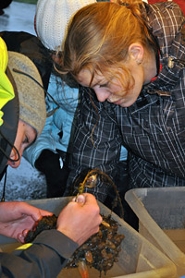
Assessing the biodiversity on an ecodesign landscape in the Oosterschelde
On December 16th 23 students of the Institute of Environmental Sciences of Leiden University took part of the first total species inventory to assess the effectiveness of an underwater landscape that was build in March 2003 to restore the biodiversity in an area where the environment was destroyed by dike restorations
Regardless of the extremely cold, windy and wet weather the students climbed down the dike and turned over rocks and stones, scoring species on monitoring forms.
Combining their findings with those of scuba-divers and students of the University of Applied Sciences in Zeeland, it was concluded that many of the species, like crabs, algae, sea-squirts, sea-horses and squids that were probably banned from the area when the dike was strengthened, had returned within a years’ time
To ensure the safety of the general public the Dutch Department of Public Works deemed it necessary to strengthen several km2 of dike in the Province of Zeeland in May 2009. The habitats and species on these dikes were destroyed in the process.

To restore the biodiversity, Van Oord and the Ministry of Public Works joined forces with delta technology institute Deltares and the marine consultancy company GiMaRIS to design and construct an underwater ecological landscape on top of the repaired dikes, with a scale unparalleled in the world.
This design called for a variety of materials, gradients and shapes to create hiding places, differences in height, and variations in exposure to current and light. To ensure flexibility, a modular system of building blocks was thought of, consisting of round, criss-crossed and atoll-shaped piles of stones, each ~20-30 m2 in size, next to linear elements. Combining these blocks enabled the creation of an underwater environment, non-artificial looking, similar to the French rocky shores.
Arjan Gittenberger (CML)
